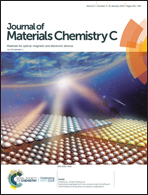Thickness-dependent resistive switching in black phosphorus CBRAM†
Abstract
The main challenge encountered by most 2D materials for their use in non-volatile memory technology is their low Ron/off ratio. Recently, black phosphorus (BP), an emerging 2D layered material has replaced transition metal dichalcogenides (TMDS) due to its unique electronic properties. In this paper, we have investigated the resistive switching behavior of BP Conductive Bridge Random Access Memory (CBRAM), in which resistive switching is driven by the formation of a metallic (Cu) filament and the active layer is solely composed of BP thin films. The on/off ratio is controlled by using different thicknesses of BP. It is notably found that the Ron/off ratio has a strong dependence on the thickness of BP. Thicker BP devices showed stable bipolar switching with a low operating voltage of 0.6 eV ± 0.1 V and an Ron/off of 104. The main hindrance to commercial applications of BP devices is that the BP films are susceptible to degradation on exposure to ambient conditions. To make these BP devices environmentally stable, we have utilized the strategy of growing native oxide on thicker BP devices as a protective layer by utilizing deep ultra violet light and elucidated an improved Ron/off up to 105. To the best of our knowledge, here, we report for the first time the resistive switching characteristics of BP CBRAM.



 Please wait while we load your content...
Please wait while we load your content...